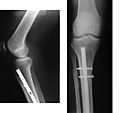Bone fracture facts for kids
A bone fracture happens when a bone breaks or cracks. Bones are usually very strong. They can handle a lot of force. But if a force is too strong, or if the bone is already weak, it can break.
Bones can break in many different ways. When a bone breaks, it's called a fracture.
Contents
Types of Bone Fractures
There are many ways to describe a bone fracture. Doctors often put them into different groups.
Open or Closed Fractures
- An open fracture (also called a compound fracture) is when the broken bone pokes through the skin. This can be serious because germs can get into the body and cause an infection. Open fractures can also hurt muscles, tendons, and ligaments.
- A closed fracture is when the bone breaks but the skin stays in one piece. The bone does not poke through.
Simple or Complex Fractures
- A simple fracture means only the bone is broken. There is no other major damage around it.
- A complex fracture means the broken bone has also damaged the soft tissue nearby. This can include muscles or nerves.
Complete or Incomplete Fractures
- A complete fracture means the bone is broken all the way through. The bone is in two or more separate pieces.
- An incomplete fracture means the bone is only partly broken. It's still in one piece, but it has a crack or a partial break.
Here are some types of incomplete fractures:
- Hairline fracture: This is a very small crack in the outer layer of the bone. It's sometimes called a fissure fracture.
- Greenstick fracture: These usually happen in children. Kids' bones are more flexible than adult bones. In a greenstick fracture, only one side of the bone breaks. The bone might bend, and the break is only on the outside of the bend. It's like trying to break a fresh, green stick – it bends and splinters, but doesn't snap completely.
Other Fracture Types
- A comminuted fracture happens when a bone breaks into three or more pieces. So, you have the main bone, plus at least three smaller pieces that have broken off.
- Multiple fractures can mean two things:
* One bone is broken in two or more different places. * A person has broken many different bones from the same injury, like from a car accident.
Most bone fractures take about 6 to 8 weeks to heal. But how fast a bone heals depends on many things. This includes which bone was broken, how bad the break was, your age (younger people often heal faster), and how well you eat (your nutrition).
How Doctors Find Fractures
Doctors usually find fractures by using an X-ray. An X-ray takes a picture of your bones. If an X-ray can't clearly show the fracture, doctors might use other scans. These can include an MRI or a CT scan. These scans give more detailed pictures of the bone and surrounding areas.
How Doctors Treat Fractures
The main goal of treating a broken bone is to make sure the broken ends are lined up correctly. They also need to be held tightly together. This helps the bone heal properly.
As experts say, "The broken pieces must be put back into position and prevented from moving out of place until they are healed. Broken bone ends heal by 'knitting' back together with new bone being formed around the edge of the broken parts."
To help with pain, doctors might give you medication. They might also suggest painkillers you can buy without a prescription.
Scientists are always looking for new ways to help bones heal. They are even exploring ideas like gene therapy and using 3-D printers to help bones grow again in the future!
- You can find more simple information about broken bones for children and teenagers (from KidsHealth.org).
Images for kids
-
Radiography to check for fractures after a knee injury.
-
An X-ray showing a broken tibia (shin bone) with an intramedullary nail inside to help it heal.
See also
 In Spanish: Fractura ósea para niños
In Spanish: Fractura ósea para niños






